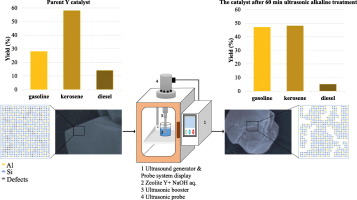当前位置:
X-MOL 学术
›
Fuel Process. Technol.
›
论文详情
Our official English website, www.x-mol.net, welcomes your
feedback! (Note: you will need to create a separate account there.)
Preparation of hierarchical structure of Y zeolite with ultrasonic-assisted alkaline treatment method used in catalytic cracking of middle distillate cut: The effect of irradiation time
Fuel Processing Technology ( IF 7.2 ) Pub Date : 2018-07-01 , DOI: 10.1016/j.fuproc.2018.03.035 Shima Oruji , Reza Khoshbin , Ramin Karimzadeh
Fuel Processing Technology ( IF 7.2 ) Pub Date : 2018-07-01 , DOI: 10.1016/j.fuproc.2018.03.035 Shima Oruji , Reza Khoshbin , Ramin Karimzadeh

|
Abstract Hierarchical structure of NaY zeolite was synthesized with conventional and ultrasonic assisted alkaline treatment methods. Furthermore, their catalytic performance was evaluated in catalytic cracking process. The synthesized catalysts were characterized using XRD, FE-SEM, N 2 adsorption-desorption and NH 3 -TPD analysis. The amount and the type of coke, which formed on the catalysts have also been studied using TGA and FTIR analysis, respectively. The XRD, FE-SEM and BET results revealed that the ultrasonic assisted alkaline-treatment method created more mesopores and lower destruction at zeolite structure, compared to conventional alkaline-treatment method. Furthermore, the results demonstrated that ultrasonic irradiation performed facile creation of hierarchical structure for NaY zeolite. The obtained results from BET analysis showed that by increasing alkaline treatment time, mesoporosity increased gradually. Also, TPD analysis revealed that desilication led to increasing acidity amount. In comparison to the Parent Y catalyst, both the superior catalytic performance and efficient decrease in viscosity, density and molecular weight of liquid product were obtained over the modified Y catalyst which was alkaline-treated, in presence of ultrasound in 60 min. Also the maximum gasoline yield over this catalyst was 47%. Well mesopore structure and moderate acidity also led to decreased coke formation rate and increased catalytic stability and activity.
中文翻译:

超声辅助碱处理法制备Y沸石分级结构用于中间馏分催化裂化:辐照时间的影响
摘要 采用常规和超声辅助碱处理方法合成了NaY沸石的分级结构。此外,还评估了它们在催化裂化过程中的催化性能。使用XRD、FE-SEM、N 2 吸附-解吸和NH 3 -TPD分析对合成的催化剂进行表征。还分别使用 TGA 和 FTIR 分析研究了在催化剂上形成的焦炭的数量和类型。XRD、FE-SEM 和 BET 结果表明,与传统的碱处理方法相比,超声波辅助碱处理方法在沸石结构上产生了更多的介孔和更低的破坏。此外,结果表明,超声辐照可以轻松创建 NaY 沸石的分级结构。BET分析结果表明,随着碱处理时间的增加,介孔率逐渐增加。此外,TPD 分析显示脱硅导致酸度增加。与母体 Y 催化剂相比,经过碱性处理的改性 Y 催化剂在 60 分钟内在超声波存在下获得了优异的催化性能和液体产物的粘度、密度和分子量的有效降低。此外,该催化剂的最大汽油产率为 47%。良好的介孔结构和适度的酸度也导致焦炭形成率降低,催化稳定性和活性增加。与母体 Y 催化剂相比,经过碱性处理的改性 Y 催化剂在 60 分钟内在超声波存在下获得了优异的催化性能和液体产物的粘度、密度和分子量的有效降低。此外,该催化剂的最大汽油收率为 47%。良好的介孔结构和适度的酸度也导致焦炭形成率降低,催化稳定性和活性增加。与母体 Y 催化剂相比,经过碱性处理的改性 Y 催化剂在 60 分钟内在超声波存在下获得了优异的催化性能和液体产物的粘度、密度和分子量的有效降低。此外,该催化剂的最大汽油产率为 47%。良好的介孔结构和适度的酸度也导致焦炭形成率降低,催化稳定性和活性增加。
更新日期:2018-07-01
中文翻译:

超声辅助碱处理法制备Y沸石分级结构用于中间馏分催化裂化:辐照时间的影响
摘要 采用常规和超声辅助碱处理方法合成了NaY沸石的分级结构。此外,还评估了它们在催化裂化过程中的催化性能。使用XRD、FE-SEM、N 2 吸附-解吸和NH 3 -TPD分析对合成的催化剂进行表征。还分别使用 TGA 和 FTIR 分析研究了在催化剂上形成的焦炭的数量和类型。XRD、FE-SEM 和 BET 结果表明,与传统的碱处理方法相比,超声波辅助碱处理方法在沸石结构上产生了更多的介孔和更低的破坏。此外,结果表明,超声辐照可以轻松创建 NaY 沸石的分级结构。BET分析结果表明,随着碱处理时间的增加,介孔率逐渐增加。此外,TPD 分析显示脱硅导致酸度增加。与母体 Y 催化剂相比,经过碱性处理的改性 Y 催化剂在 60 分钟内在超声波存在下获得了优异的催化性能和液体产物的粘度、密度和分子量的有效降低。此外,该催化剂的最大汽油产率为 47%。良好的介孔结构和适度的酸度也导致焦炭形成率降低,催化稳定性和活性增加。与母体 Y 催化剂相比,经过碱性处理的改性 Y 催化剂在 60 分钟内在超声波存在下获得了优异的催化性能和液体产物的粘度、密度和分子量的有效降低。此外,该催化剂的最大汽油收率为 47%。良好的介孔结构和适度的酸度也导致焦炭形成率降低,催化稳定性和活性增加。与母体 Y 催化剂相比,经过碱性处理的改性 Y 催化剂在 60 分钟内在超声波存在下获得了优异的催化性能和液体产物的粘度、密度和分子量的有效降低。此外,该催化剂的最大汽油产率为 47%。良好的介孔结构和适度的酸度也导致焦炭形成率降低,催化稳定性和活性增加。











































 京公网安备 11010802027423号
京公网安备 11010802027423号